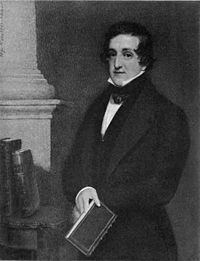Prime Minister Lord John Russell Party Whigs Monarch Queen Victoria Spouse Julia Hay (m. 1828) | Role British Politician Name John 1st Resigned November 1834 | |
 | ||
Monarch William IVQueen Victoria Books Italy 2 Volume Set: Volu, Recollections of a Long Life, Travels in Albania and Other, Contemporary Account of the Separ, Imitations and Translatio | ||
Prime Minister The Viscount Melbourne Succeeded by The Lord Ellenborough Preceded by The Lord Ellenborough | ||
John Cam Hobhouse, 1st Baron Broughton, (27 June 1786 – 3 June 1869), known as Sir John Hobhouse, Bt, from 1831 to 1851, was a British politician and diarist.
Contents
Early life
Born at Redland near Bristol, Broughton was the eldest son of Sir Benjamin Hobhouse, 1st Baronet, and Charlotte, daughter of Samuel Cam. He was educated at Westminster School, and at Trinity College, Cambridge. At Trinity College Hobhouse became friends with Lord Byron, and accompanied him in his journeys in the Peninsula, Greece and Turkey, and acted as his "best man". In 1816 he was with Byron after his separation from his wife, and contributed notes to the fourth canto of Childe Harold, which was dedicated to him.
Career
On his return he threw himself into politics with great energy as an advanced Radical, and wrote various pamphlets, for one of which he was in 1819 imprisoned in Newgate. Also in that year, he spoke the following words: "I am a man chosen for the people, by the people; and, if elected, I will do no other business than that of the people". In 1820, he entered Parliament, sitting for Westminster.
Hobhouse is credited with the invention of the phrase His Majesty's (Loyal) Opposition made in 1826 during a speech in the House of Commons. After the Whigs gained power in 1830 he served under Lord Grey as Secretary at War between 1832 and 1833, as Chief Secretary for Ireland in 1833 and as First Commissioner of Woods and Forests in 1834. He was later President of the Board of Control under Lord Melbourne between 1835 and 1841 and under Lord John Russell between 1846 and 1852. He was sworn of the Privy Council in 1832 and raised to the peerage as Baron Broughton, of Broughton-de-Gyfford in the County of Wiltshire, in 1851. In 1852 he was also made a Knight Grand Cross of the Order of the Bath (GCB).
Family
Lord Broughton married Lady Julia, daughter of George Hay, 7th Marquess of Tweeddale, in 1828. They had three daughters. Lady Julia died from tuberculosis in April 1835. Lord Broughton survived her by over 30 years and died in June 1869, aged 82. He is buried at Kensal Green Cemetery, London. The large and distinctive monument lies on the main pathway to the central chapel.
His barony died with him, as he had no male heirs, whilst the baronetcy created for his father passed to Broughton's nephew, Charles.
Works
He published Journey through Albania (1813), Historical Illustrations of the Fourth Canto of Childe Harold (1818), and Recollections of a Long Life (1865), for private circulation, and he left in MS. Diaries, Correspondence, and Memoranda, etc., not to be opened till 1900, extracts from which were published by his daughter, Lady Dorchester, also under the title of Recollections from a Long Life (1909).
